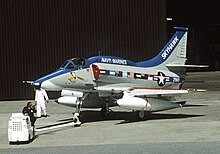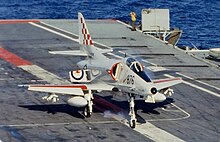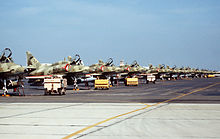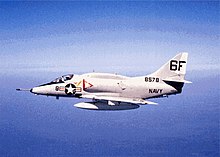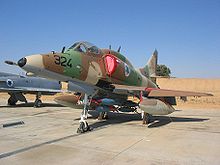Douglas A-4
| Douglas A-4 Skyhawk | |
|---|---|
 An A-4E "Skyhawk" of the US Navy 1967 |
|
| Type: | Fighter bomber |
| Design country: | |
| Manufacturer: | |
| First flight: |
June 22, 1954 |
| Commissioning: |
October 1956 |
| Production time: |
1955 to 1979 |
| Number of pieces: |
2960 |
The Douglas A-4 Skyhawk was a single-engine fighter aircraft made in the USA . The Skyhawk was designed as an inexpensive fighter-bomber for use on aircraft carriers .
construction
When the designer Ed Heinemann presented the A -4, many experts told him that this aircraft would fail because it was too small and too light: the design weighed only 2.5 tons. After the first flight on June 22, 1954, a different picture emerged: 2960 units of this type of aircraft were built (555 of which were two-seat training aircraft ). As one of the very few aircraft carrier types, the A-4 had no folding surfaces because its wingspan was small enough for the deck elevator. With the design as an inexpensive close-air support aircraft, one wanted to do without a radar device. Although designed as a fighter-bomber, the Skyhawk can defend itself against interceptors thanks to its maneuverability, automatic cannons and IR guided missiles. By doing without a nose radar, the silhouette could be kept slim and short. The fight against ground targets was carried out either visually or blindly by means of dropping according to the information provided by the weapons control computer in the HUD . Later variants were equipped with self-protection systems such as radar warning devices combined with decoys. The A-4M used laser aiming illumination units in the nose. The last copy rolled off the assembly line on February 27, 1979. From the twelfth year of production (1966) onwards, all A-4s (except the two-seater) have the typical "camel hump" behind the cockpit, which contains additional all-weather navigation and fire control systems.
commitment

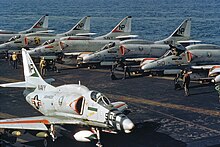
Argentina
Argentina flew the A-4P / Q from 1965 to 1999 and the A-4AR since then. In 1982 the Argentine Skyhawks were used in the Falklands War. 19 A-4P and 3 A-4Q were lost. In turn, the A-4P / Q sank the destroyer HMS Coventry (D118) , the frigates HMS Antelope (F170) and HMS Ardent (F184) and the landing ship RFA Sir Galahad (L3005) . The last A-4AR are to be operated until 2018.
Australia
Australia used 16 A-4F / G and 4 TA-4F / G from 1967 to 1982, the remaining ten aircraft were sold to New Zealand . The A-4K has been flown here since 1970. They were extensively modernized from 1985 to 1989 and decommissioned from 2001 to 2004.
Brazil
Brazil has been using the A-4 since 1997 . 20 A-4KU and 3 TA-4KU were purchased from Kuwait . They are now referred to as AF-1 and AF-1A, used by the aircraft carrier Sao Paulo (formerly French aircraft carrier Foch ) and are currently (as of 2015) being modernized. They should remain in use until around 2025.
Germany
Since 2001, six civil, formerly Israeli, A-4Ns have been flying from Wittmund Air Base ( Jagdgeschwader 71 ) as target display aircraft for the Air Force . The copies originally belonged to BAE Systems , which flew them through EIS Aircraft GmbH as a subcontractor. The civil license plates of the A-4N were N431FS, N432FS, N434FS and N437FS. Since 2015 the company Discovery Air Defense Services has been providing this service for an initial five years, also with its own A-4N registered in the Canadian civil register.
Indonesia
Indonesia bought 14 A-4E and 2 TA-4H from Israel in 1979, 16 A-4E from the United States in 1982, and 2 TA-4J in 1999. The decommissioning took place until 2004.
Israel
The largest user after the United States was Israel . About 350 A-4E / H / N and TA-4H were delivered to Israel between 1968 and 1973. The A-4N in particular have been continuously modernized. Since the beginning of the 1990s, the TA-4H / A-4N have only been used for pilot training from the Chazerim military airfield and from 2003 to 2005 RADA Electronic Industries Ltd. modernized. 50 Skyhawks with Inertial Navigation System (INS), Head-Up-Display (HUD), Global Positioning System (GPS), Ring Laser Gyro (RLG) and Airborne Video Recorder. The decommissioning took place in December 2015.
Kuwait
In the second Gulf War , the A-4KU was flown under the Kuwaiti flag. They worked there from 1976 to 1997. In use, only one Skyhawk was lost due to being shot down and 12 more due to other reasons.
Malaysia
In 1982 Malaysia bought 40 A-4C / L from the United States (referred to as A-4PTM = "peculiar to Malaysia"), which flew until 1999.
Singapore
In 1972 Singapore bought 47 A-4B. These were extensively modernized from 1984 to 1989, including the F404-GE-100D engine and known as the "A-4SU". In 2007 it was taken out of service.
United States
The Skyhawk was mainly flown by the US Navy and the US Marine Corps . The USN actively used the A-4F until 1975. On December 5, 1965, an A-4E Skyhawk with a B43 atomic bomb fell from an elevator of the USS Ticonderoga (CV-14) into the sea and sank over 4,900 meters. The pilot, bomb and aircraft were never recovered (as of March 2010). The aircraft carrier was located 130 kilometers east of the Japanese Ryūkyū Islands on the way from Vietnam to the Japanese Yokosuka.
During the Vietnam War, from August 5, 1964 to the last case on September 6, 1972, 356 total casualties of A-4 Skyhawk (271 in the United States Navy , 85 in the United States Marine Corps ), of which at least 195 were in combat missions.
In the end, only the VA-55, VA-164 and VA-212 squadrons flew with the carrier wing CVW-21 (Tailcode NP) on the USS Hancock (CV-19) . The Blue Angels aerobatic team flew the A-4F until 1986. The TA-4J were retired from the training squadrons in 1999, the last user was the VT-7 on NAS Meridian. To represent the enemy , the VC-8 squadron flew the TA-4J until 2003. The USMC flew the A-4M until 1990 with the VMA-211 squadron, the Marine Corps Reserve decommissioned the last machine in 1994 with the VMA-131.
variants
- XA4D-1
- Prototype, BuNo. 137812
- A-4A (until 1962 A4D-1)
- 165 built, Wright J65-W-4 engine (license from Armstrong Siddeley "Sapphire")
- A-4B (A4D-2)
- 542 built, J65-W-16A, air refueling tube, new vertical stabilizer
- A-4C (A4D-2N)
- 638 built, J65-W-16A / -20, radar in a longer nose
- A-4D (A4D-3)
- Proposed A-4B with Pratt & Whitney J52-P-2 engine, not built
- A-4E (A4D-5)
- 499 built, J52-P-6A (therefore 27% more range), two more underwing stations
- A-4F
- 147 built, 0-0 ejection seat, improved avionics (also in "humps" behind the cockpit), last new version built for the US Navy, in use until 1975
- TA-4F
- 241 built, two-seat trainer version (originally TA-4E), J52-P-8A
- EA-4F
- Conversion of some TA-4F with ECM as enemy representation aircraft (flew with VAQ-33 squadron)
- A-4G
- 8 built, A-4E for Australia, used by the aircraft carrier HMAS Melbourne
- TA-4G
- 2 built, TA-4F for Australia
- A-4H
- 90 built, A-4F for Israel, angular tail unit, 30 mm DEFA cannons
- TA-4H
- 25 built, TA-4F / J for Israel
- TA-4J
- 277 built, two-seat trainer version without combat equipment of the TA-4F
- A-4K
- 10 built, A-4F for New Zealand
- TA-4K
- 2 built, TA-4F for New Zealand
- A-4KU
- Built 30, A-4M for Kuwait, 20 were sold to Brazil and be there as AF-1 denotes
- TA-4KU
- 6 built, TA-4J for Kuwait (Brazilian TA-4KU: AF-1A )
- A-4L
- Conversion of 100 A-4C with J65-W-20, avionics humps, two additional underwing stations, flew at the Naval Reserve
- A-4M
- 158 built, J52-P-408A, improved avionics, increased cockpit, increased weapon load, braking parachute (only flown by the US Marine Corps)
- OA-4M
- Conversion of 23 TA-4Fs for the USMC, avionics humps, Hughes ARBS bomb sighting device
- A-4N
- 117 built, A-4M for Israel, 30mm DEFA cannons
- A-4P
- 50 ex-A-4B for Argentina ( Air Force )
- A-4Q
- 16 ex-A-4B for Argentina (Navy, use of the aircraft carrier "25 de Mayo"), J65-W-20
- A-4AR
- 32 A-4Ms that were sold to Argentina in the late 1990s
- A-4S
- 98 ex-A-4B / C for Singapore, British avionics, 30 mm Aden cannons, two additional underwing stations, conversion to the A-4SU
- TA-4S
- 9 ex-A-4B / C, trainer version analogous to A-4S, but with two separate cockpits
- A-4SU
- Conversion of the A-4S with General Electric F404-100D engine, head-up display GEC-Marconi 4150 and Litton-LN-92 avionics as well as the possibility to fire AGM-65 Maverick air-to-ground missiles. In 2005 the aircraft of the combat squadrons were decommissioned, in 2007/08 those of the training squadrons from Cazaux (France) followed
Technical specifications
| Parameter | Douglas A-4M data |
|---|---|
| Length: | 12.27 m |
| Height: | 4.57 m |
| Wingspan: | 8.38 m |
| Wing area: | 24.16 m² |
| Empty weight: | 4747 kg (A-4A = 3490 kg) |
| Maximum take-off weight: | 11,113 kg (carrier-supported) /12,427 kg (from land) |
| Engine: | a Pratt & Whitney J52 -408A jet engine with 5080 kp |
| Top speed: | 1105 km / h |
| Service ceiling: | 14,600 m |
| Operational range: | 1408 km |
| Transfer range: | 3307 km |
| Rescue system | Douglas ESCAPAC IG-3 ejection seat |
Armament
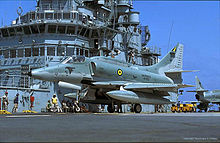
Airborne cannons in the wing roots
- 2 × 20 mm Colt Mk.12 automatic cannons with 100 rounds of ammunition each (200 rounds each for variant A-4M)
- 2 × 30 mm revolver machine guns DEFA 552 with 150 rounds of ammunition each (variants A-4H / N / SU)
At four under wing stations (A-4A / B / C / Q / P two under wing stations) and one under wing stations for a maximum of 4,153 kg of ordnance
Air-to-air guided missile
- 2 × LAU-7 / A start rails for 1 × Ford AIM-9B "Sidewinder" each - infrared-controlled, self-targeting for short distances
Air-to-surface guided missile
- 4 × LAU-117 / A launch rails for 1 × Raytheon AGM-65A / B / D / F / G "Maverick" - guided missiles against ships or tanks
- 4 × LAU-118 star rails for each 1 × Texas Instruments AGM-45A / B "Shrike" - self-targeting anti-radar missile
- 5 × Martin Marietta AGM-12A / B "Bullpup" - radio-controlled guided missile against static ground targets
Unguided air-to-surface missiles
- 3 × BRU-42 TER (Triple Ejection Rack) with 3 × LAU-10D / A rocket tube launchers each for 4 × unguided Zuni air-to-surface rockets (caliber 127 mm / 5 inch)
- 3 × BRU-42 TER (Triple Ejection Rack) each with 3 × LAU-3 / A rocket tube launch containers for 7 × unguided FFAR air-to-surface rockets (caliber 70 mm rockets / 2.75 inch)
Guided bomb
- 2 × Martin Marietta AGM-62 "Walleye II" (TV-guided glide bomb with Mk.84 explosive device)
Unguided bombs (on up to three BRU-42 TER bomb carrier racks)
- 9 × CBU-100 / Mk.20 "Rockeye II" (222 kg / 490 lb anti-tank cluster bomb with 247 Mk.118 bomblets)
- 4 × Mk.7 "Rockeye" (fragmentation bomb)
- 12 × Mark 81 LDGP ( free fall bomb )
- 6 × Mark 82 LDGP (241 kg / 500 lb free fall bomb)
- 3 × M117 (372 kg / 820 lb free fall bomb)
- 5 × Mark 83 LDGP (454 kg / 1000 lb free fall bomb)
- 1 × Mark 84 LDGP (907 kg / 2000 lb free fall bomb)
- 2 × Mk. 79 (500 kg napalm bomb)
- 1 × Mk 8 (tactical nuclear free-fall bomb)
- 1 × Mk 12 (tactical nuclear free-fall bomb)
- 1 × Mk 91 (tactical nuclear free-fall bomb)
- 1 × B28 (nuclear free-fall bomb)
- 1 × B43 (nuclear free-fall bomb)
- 1 × B57 (tactical nuclear free-fall bomb)
- 1 × B61-2 / 5 (tactical nuclear free-fall bomb)
- 4 × Mk 76 (practice bomb)
Additional container
- 3 × Mk 4 (20 mm automatic cannon vessels for 4,000 rounds of ammunition)
- 1 × Aero 14B spray tank (spray tank for chemicals)
- 1 × additional drop tank for 1487 liters (400 US gallons) of kerosene
- 1 × Aero 1D drop-off auxiliary tanks for 1115 liters (300 US gallons) of kerosene
- 1 × Aero 1C drop-off auxiliary tanks for 565 liters (150 US gallons) of kerosene
- 1 × CNU-188 / A luggage container
- 1 × LB-18A reconnaissance canister
- 1 × SUU-40 flare container
- 1 × air fuel tank Douglas D-704 with basket and hose
Self defense
Active measures
- 2 × Tracor AN / ALE-29A decoys with 30 decoys each (36 mm diameter e.g. RR-129 chaff cartridges or MJU-8 / B heat flares ). The two flare launchers are installed on the underside of the stern .
Passive action
- 3 × Itek AN / APR-25-ESM gondolas, each with a radar warning sensor
- 4 × Litton AN / ALR-45C (V) -ESM gondolas, each with a radar warning sensor
Operator Air Forces
Douglas manufactured a total of 2960 Skyhawk series aircraft in Long Beach , California . The specified number of items (if known) includes newly delivered, used and converted machines.
- 127 (50 A-4P, 25 A-4C, 16 A-4Q, 36 A-4AR)
- 20 (16 A-4G, 4 TA-4G) 1967 8 A-4G and 2 TA-4G, 1971 8 A-4F and 2 TA-4F
-
 Brazil ( Marinha do Brasil ):
Brazil ( Marinha do Brasil ):
- 23 (20 A-4KU, 3 TA-4KU)
- 32 (30 A-4E / H, 2 TA-4H)
-
 Israel ( Israeli Air Force ):
Israel ( Israeli Air Force ):
- 278 (46 A-4E, 90 A-4H, 117 A-4N, 25 TA-4H)
-
 Kuwait ( Kuwait Air Force ):
Kuwait ( Kuwait Air Force ):
- 36 (30 A-4KU, 6 TA-4KU)
- 133 (40 A-4S, 7 TA-4S, 86 A-4SU)
- 88 (34 A-4PTM, 6 TA-4PTM, 48 A-4C,? A-4H)
- 30 (18 A-4K, 2 TA-4K) 1984 8 A-4G, 2 TA-4G
- ( United States Navy and United States Marine Corps ):
- 2638 (166 A-4A, 542 A-4B, 638 A-4C, 499 A-4E, 147 A-4F, 100 A-4L, 158 A-4M, 23 OA-4M, 241 TA-4F, 247 TA- 4J)
Miscellaneous
- On May 1, 1967 LtCdr Theodore Swartz succeeded in shooting down a MiG-17 - fighter aircraft with unguided Zuni missiles - what was particularly unusual was that the Zuni is a pure air-to-ground missile.
- In the film The attack , an A-4H "Achit" is shot down with an atomic bomb over Syria.
See also
Web links
McDonnell Douglas A-4 Skyhawk History (English)
Individual evidence
- ↑ Argentina to retire aging A-4AR fleet by 2018, Janes, July 27, 2016 ( Memento of the original from July 28, 2016 in the Internet Archive ) Info: The archive link was inserted automatically and has not yet been checked. Please check the original and archive link according to the instructions and then remove this notice.
- ↑ James Drew: Embraer hands first modernized AF-1B carrier jet to Brazilian Navy. In: Flightglobal.com. May 27, 2015, accessed on May 28, 2015 (English): "Embraer has handed the Brazilian Navy the first of 12 modernized AF-1B intercept and attack jets through a program aimed at extending the service life of the carrier-based aircraft through to 2025. "
- ^ IAF retires Skyhawk trainer fleet, Flightglobal, December 15, 2015
- ↑ Chris Hobson: Vietnam Air Losses, USAF, USN, USMC, Fixed-Wing Aircraft Losses in Southeast Asia 1961–1973 . North Branch, Minnesota: Specialty Press, 2001, ISBN 1-85780-115-6 . (English)
- ↑ http://www.specialtypress.com/specialty/contentfiles/281.pdf ( Page no longer available , search in web archives ) Info: The link was automatically marked as defective. Please check the link according to the instructions and then remove this notice. , accessed February 13, 2010







